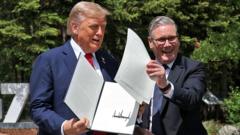In a pivotal moment for Canada's political landscape, Canadians are heading to the polls on April 28, 2025, to elect a leader during a tumultuous time marked by President Trump's economic threats and a shifting political environment. Polls show a surprising surge for the Liberal Party, now led by Mark Carney, as it competes against the Conservative Party’s Pierre Poilievre. Once viewed as the firm frontrunners with a 25-point lead, the Conservatives now face a narrower race after a series of events that have altered public sentiment.
Canada's Election: Mark Carney vs. Pierre Poilievre Amidst Economic Turmoil and Trump’s Impact

Canada's Election: Mark Carney vs. Pierre Poilievre Amidst Economic Turmoil and Trump’s Impact
Canadians are casting their votes in a pivotal election influenced by President Trump's threats and economic challenges.
The election comes at a crucial juncture where Canadians are concerned about Trump's tariffs, which many fear will worsen economic conditions, leading to job losses and potential recession. The stark choices posed by Carney and Poilievre reflect distinct perspectives on Canada's future: Carney, a centrist and former central banker championing economic stability and sovereignty; and Poilievre, a provocative figure aiming for deregulation and smaller government.
In addition to the major parties, three others are contesting the election: the left-leaning New Democratic Party, the environmentalist Greens, and the Quebec-focused Bloc Québécois. However, the main focus remains on the fierce competition between Carney and Poilievre, as they represent diverging paths for Canada in the fight against external pressures.
Meanwhile, issues surrounding immigration, once dominating the discourse in the lead-up to the election, have taken a backseat in voter priorities, overtaken by economic stability, housing crises, and concerns over Trump’s influence. In suburban centers like Brampton, where immigrant populations are significant, the focus has shifted from immigration policy to economic safety and crime control.
As polls open across six time zones in Canada, the logistical challenge of counting votes from a complex electoral base comes into play. Results are expected shortly after the polls close late Monday night, as Canadians closely monitor the influence of Trump's rhetoric and policies on their electoral choices and the future direction of their country.
Ultimately, this election stands as a reflection of shifting political tides, voter concerns over economic sovereignty, and the impact of international influences on Canadian governance, as citizens engage in shaping their nation's future at a critical crossroads.
In addition to the major parties, three others are contesting the election: the left-leaning New Democratic Party, the environmentalist Greens, and the Quebec-focused Bloc Québécois. However, the main focus remains on the fierce competition between Carney and Poilievre, as they represent diverging paths for Canada in the fight against external pressures.
Meanwhile, issues surrounding immigration, once dominating the discourse in the lead-up to the election, have taken a backseat in voter priorities, overtaken by economic stability, housing crises, and concerns over Trump’s influence. In suburban centers like Brampton, where immigrant populations are significant, the focus has shifted from immigration policy to economic safety and crime control.
As polls open across six time zones in Canada, the logistical challenge of counting votes from a complex electoral base comes into play. Results are expected shortly after the polls close late Monday night, as Canadians closely monitor the influence of Trump's rhetoric and policies on their electoral choices and the future direction of their country.
Ultimately, this election stands as a reflection of shifting political tides, voter concerns over economic sovereignty, and the impact of international influences on Canadian governance, as citizens engage in shaping their nation's future at a critical crossroads.





















